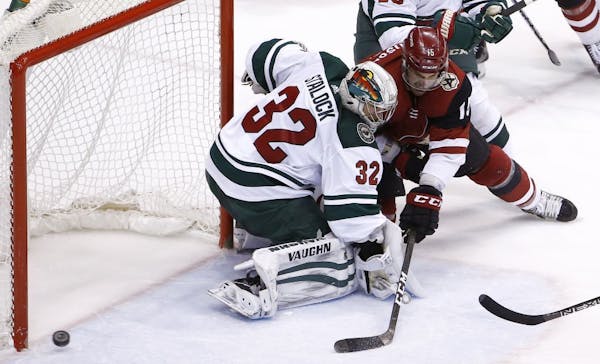The NBA and NHL regular seasons are 82-game grinds filled with ups and downs. With that in mind, it's never a good idea to read too much into an individual game that amounts to barely more than one percent of the entire schedule.
That said, both the Wild and Wolves played Thursday in what turned out to be "one of those nights" in Minnesota sports where things look good, change to frustrating and end poorly. And in each case, the potentially fatal flaws of both teams were on display in losses.
*For the Wild, which lost first, the problems are more subtle. The first is a lack of urgency, which head coach Bruce Boudreau called out after Thursday's 5-3 loss to Arizona — the worst team in the league. That tends to happen to veteran teams, and the Wild not only has the third-oldest roster in the NHL at 29.2 years old but also has a roster that has remained very much intact for several years of modest success. When players know they're good, and things start to come easy, letdowns happen.
"They tried to be way too cute instead of doing what they've been doing the last three games," Boudreau said of the top line of Eric Staal, Jason Zucker and Mikael Granlund. "They're tic-tac-toing it and think the game is going to be this easy all the time, and it's not this easy all the time."
The second issue is one that has broader playoff implications. Last season, the Wild had a top-10 power play and top 10 penalty kill, scoring 47 power play goals while allowing just 37 while short-handed. This season, they've already allowed 43 goals on opposing power plays while scoring 41. Their percentages aren't all that bad, but they've allowed 30 more power plays than they've earned this season.
Arizona tied the score with a power play goal Thursday, and while the Wild got one back in the third period on the man advantage, the momentum had already turned to the Coyotes. In the postseason, when special teams are magnified, this could be an even bigger issue.
*The Wolves' problem on display Thursday has been an issue for a long time: three-point shooting. They finished just 4 of 20 from long distance in a 108-99 loss to Portland, and that overall mark was bolstered by two makes in the closing moments when the outcome was already decided.
For the season, the Wolves are in the bottom 10 in the NBA in three-point percentage, while they are second-to-last in both three-pointers made (7.9) and attempted (22.2) per game. The league average this year is 10.4 makes per game and 28.8 attempts.
Minnesota has the third-most efficient offense in the NBA, which mitigates some of the damage done by their poor three-point numbers. But the lack of consistent three-point makers and takers hurts the Wolves in close games against teams like Portland, which only made 9 of 30 (30 percent) but had the confidence to keep taking (and eventually making in the fourth quarter) long-range shots that turned the game in its favor. The three-point disparity is also a big reason the Wolves lag far behind Western Conference powers Houston (NBA-best 15.5 threes made per game on a whopping 42 attempts) and Golden State (NBA-best 39.9 percent accuracy from long distance).
Both the Wild and Wolves are still in prime position to reach the postseason even after frustrating losses, and both could still make some noise in the playoffs. But the recipe for the ultimate undoing of both was on display Thursday.
Lillard practices fully and Antetokounmpo remains out of live drills as Bucks prepare for playoffs
Olympic organizers unveil strategy for using artificial intelligence in sports
Olympic torch makes Acropolis overnight stop a week before handover to Paris organizers
Quarterback of the future? This Vikings mystery is about to end.

